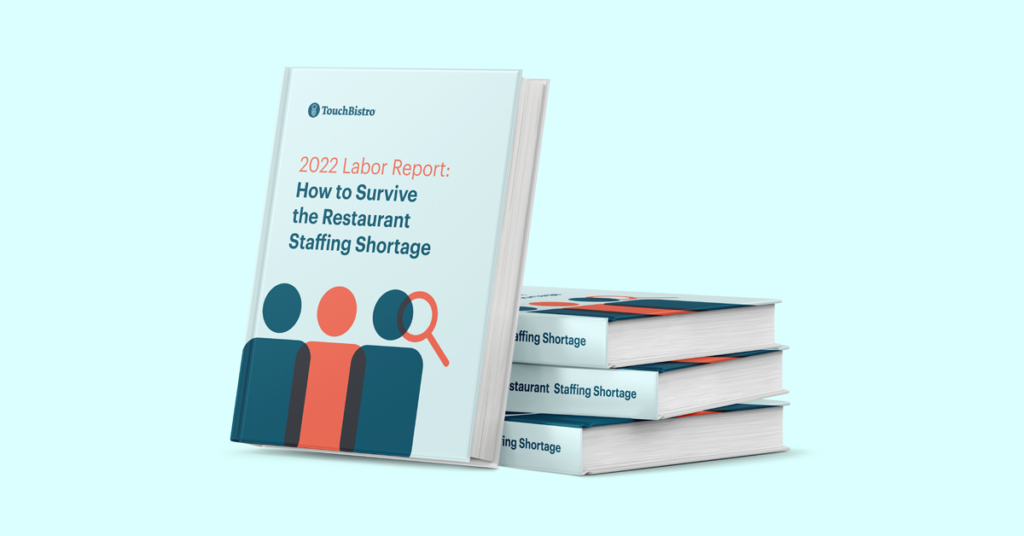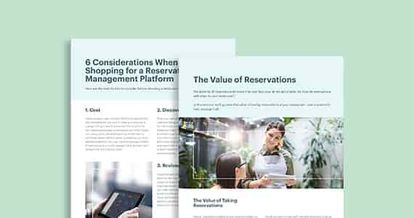Prior to the pandemic, 61% of operators offered higher wages to stay competitive and combat turnover, according to TouchBistro’s 2022 Labor Report. Today, most restaurants can’t afford to continuously increase wages, so they have to become more thoughtful and creative when it comes to retaining talent. That’s where building an employee retention strategy comes into play – a roadmap for keeping your top talent happy and engaged.
To dive deeper into this topic, we interviewed Jim Taylor, Founder and CEO of Benchmark Sixty, who shares his insight on how to build an effective employee retention strategy. Based on his wealth of experience, Jim shares his perspective on:
- Why employee retention is so important
- 5 proven employee retention strategies for restaurants

Get 3 actionable strategies for finding, hiring, and keeping great restaurant staff.
Introducing Jim Taylor: Creator of Benchmark Sixty
Jim Taylor is the Founder and CEO of Benchmark Sixty, an innovative labor and retention consulting firm based in Vancouver, British Columbia.
Before starting his business, Jim had a successful career at Cactus Club Cafe in Vancouver. There, he held various front of house roles, starting as a host and working his way up to become the Executive Regional Manager. As Regional Manager, he helped restaurateurs grow their financial and operational strategies.
With first-hand restaurant experience and a deep understanding of the importance of employee retention, Jim left his position with Cactus Club Cafe in 2020 to start Benchmark Sixty. At Benchmark Sixty, Jim’s team of leading restaurant consultants focus on two core strategies. The first strategy is to help restaurateurs improve overall business productivity and output, so they can battle rising costs without raising prices or cutting staff. The second is to measure and protect employee workload to prevent burnout and ultimately lower staff turnover.
Armed with this strategic two-pronged approach, Benchmark Sixty works with over 300 restaurateurs annually to help them leverage data to improve margins and increase productivity so they can continue to be successful given the dramatic changes in the industry.

Why Restaurant Employee Retention is Essential
So why is retention so important?
Restaurant retention strategies not only ensure that your top talent stays with your team, but an effective plan can also increase engagement and boost productivity, which ultimately leads to higher revenue. Without these restaurant staff retention strategies in place, the likelihood of turnover increases, which in turn leads to more time and money spent on training new staff – something that’s increasingly challenging amidst the ongoing labor shortage.
And with the average cost of training a new employee clocking in at a whopping $3,560, according to TouchBistro’s State of Restaurants Report, there’s no question that this will have a direct and significant impact on your bottom line. These are costs that can add up quickly, especially with the industry’s average turnover rate sitting at 26%.
With so much money going toward labor costs, it’s easy to see how restaurant turnover can have a significant impact on a restaurant’s overall financial health. As Jim explains, “If we can help restaurant operators understand how to improve employee retention and engagement, that’s potentially tens of thousands of dollars in savings. That’s also why our whole team has t-shirts that say, ‘retention is the new cool’ – that’s our tagline!”

Get 3 actionable strategies for finding, hiring, and keeping great restaurant staff.
5 Restaurant Employee Retention Strategies
If you want to negate the high cost of employee turnover and improve employee retention and engagement, the best place to start is by identifying and honing your most important restaurant management skills. These skills can help you understand why your staff want to leave in the first place so you can identify and address any problems immediately.
Here are five proven restaurant retention strategies that Jim recommends:
1. Measure and Protect Employee Workload
The first strategy that Jim recommends is to pay close attention to employee workload in order to prevent your employees from experiencing burnout. Burnout – defined as the “emotional, mental and physical exhaustion brought on by prolonged or repeated stress” according to Psychology Today – is very common in restaurants, and has been for several decades. To prevent burnout, it’s absolutely critical to pay attention to how hard your staff are working and the impact that workload is having on their physical and mental health
For instance, Benchmark Sixty conducted a case study of a mid-size restaurant brand and found that across the company’s 12 locations, none were able to consistently achieve the labor cost percentage targets that had been set based on historical and understood data. Benchmark Sixty uncovered that the source of the problem was a recent uptick in staff turnover, which in turn put greater pressure on the rest of the team. Armed with this data, Benchmark Sixty worked with the restaurant to set more responsible and realistic labor targets that would help to ease the burden on the restaurant’s staff.
To keep track of employee workload and set realistic labor targets like in the example above, Jim suggests that restaurateurs measure and understand how hard their whole team needs to work in order to achieve a target result, like an increase in sales, for example.
If a restaurant team is working too hard to reach a specific target, Jim recommends taking a closer look at the business model to see if any changes should be made. “We take a data-driven approach to proactively measure employee workload in order to help operators understand what the thresholds are, how to prevent crossing them, and how to improve retention,” he explains.
In short, it’s a matter of being realistic about your team’s capacity. “We need to protect how hard people have to work and make sure that we’re not stressing people out, while still ensuring the customer gets a good experience. That’s really a big part of the labor concept that a lot of restaurateurs don’t think about,” Jim explains.
After all, there is a difference between hard work and having to work too hard.
2. Create a Consistent Employee Experience
In addition to reducing workload to prevent burnout, Jim also suggests that restaurateurs try to achieve a consistent employee experience. In this case, consistency means assigning the same amount of work on a regular basis so that it becomes predictable.
For example, creating consistency for your front of house staff could mean assigning each server to turn the same amount of tables per shift, or to achieve the same sales targets in a given day. It could also mean setting expectations like punctuality and attendance, or setting a target time for how quickly staff should prepare a table for future diners.
By setting achievable targets that employees can meet on a day-to-day basis, they are less likely to experience burnout. And in turn, restaurant operations will become more predictable as well.
“If staff know how their shift is going to go before they come into work, it relieves stress and anxiety by creating a more consistent work experience,” Jim says. “If they come to work and don’t know that they’ll have a 10-table section to cover, that’s not typically a very positive experience.”

3. Leverage Data From Your POS (and Other Technology)
Data gathered from your POS and other technology can also help inform your restaurant staff retention strategy. Information like average number of customers served per shift, sales volume, and staff hours worked are crucial pieces of information that can help you measure employee productivity and workload.
For instance, regarding the case study Benchmark Sixty conducted, data proved to be a valuable piece of the restaurant’s retention puzzle. In the case of that restaurant, Benchmark Sixty worked closely with the restaurant’s executive and finance departments to reverse engineer the company’s data and to more accurately forecast what would need to happen in order to increase productivity levels and achieve profitability targets.
While not every restaurant needs to go as far as reverse engineering its data, a good place to start is pulling labor data from your POS. After collecting this information, Jim suggests using this data to determine how many staff need to be scheduled during each shift. If you schedule the right amount of staff per shift and avoid understaffing your restaurant, you’ll prevent your team from carrying a heavier workload and feeling overworked – a simple, but effective strategy.

Get 3 actionable strategies for finding, hiring, and keeping great restaurant staff.
4. Invest in Training Your Employees
If you’re looking for another way to reduce employee turnover in restaurants and boost employee retention, consider investing in skills training. In fact, 61% of U.S. workers say that upskilling opportunities are an important reason to stay at their job according to a 2021 Gallup study, with a further 71% saying job training and development increased their job satisfaction.
Furthermore, employee training can help your team practice different skills and build confidence in their role. For example, imagine a group of four people arrive at your restaurant and are greeted by your most junior, least well-trained server. Without adequate practice, this entry-level employee may be easily stressed out. If that person gets overwhelmed, they may start to give inaccurate wait times because they are afraid of upsetting customers. In turn, this can create more problems for the rest of your front of house staff.
However, if you were to help this employee learn to improve their communication skills and how to use your reservation system to provide accurate wait times, this employee would gain confidence in their role significantly faster than if they were left to figure things out on their own.

5. Improve Productivity
While preventing burnout and improving mental health in restaurants should always be a top priority, there are other innovative ways to retain workers. For example, boosting productivity in the workplace can help employees stay focussed on their role, feel engaged, and choose to stay with your business. Research by Gallup also shows that productivity contributes to a company’s health and potential for growth.
Jim suggests a more productive team can keep labor costs to a minimum by allowing you to do more with a smaller staff. And when you need fewer staff to accomplish the same amount of work, you can save on labor costs.
“Our goal is to help restaurants understand how to look at data differently, so they can improve the level of productivity, which on its own will lower labor costs without raising prices or cutting staff,” Jim says. “If an employee can go from serving 10 customers in an hour to 10.2 customers in the same hour, that’s an example of increasing productivity.”
And increasing the number of customers served per hour is just one example of boosting staff productivity. Other strategies include using a mobile POS system so staff spend less time walking back and forth to the POS station or adding online ordering so staff are no longer tied up answering the phone.
When several of these strategies are employed at once, this translates into big savings. “If a restaurant brings in three million dollars a year in revenue, and achieves a 5% improvement in productivity, that typically equates to somewhere between $60,000 to $80,000 of opportunity annually,” Jim explains. “And the reason that there’s such a range is because it depends on pricing strategy and what market they’re in.”
Having an internal employee retention strategy is essential to measuring and protecting employee workload so you can ultimately prevent burnout. When coming up with your own restaurant goals, Jim recommends trying to think outside the box to boost engagement and employee morale, like offering a benefit or perk that isn’t direct wages. While it can be tempting to simply cut staff or raise prices to reduce labor costs, focusing on the importance of employee retention and reducing staff turnover can actually be the key to running a more profitable restaurant.

Get 3 actionable strategies for finding, hiring, and keeping great restaurant staff.
Download your free employee handbook template
Sign up for our free weekly TouchBistro Newsletter







